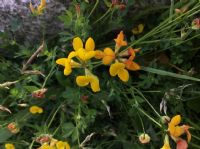|
Bird’s-foot trefoil (Lotus Corniculatus)
Back to Nature news

Bird’s-foot trefoil (Lotus Corniculatus)
© Joan Stacey
Bird’s-foot trefoil (Lotus Corniculatus)
Date added: 27/07/2020 16:16:51
Author: Joan Stacey
Look for this low-growing plant in areas of short grass. It has clusters of small flowers, mainly yellow tinged with orange and red and shaped like little slippers. Their appearance has resulted in the nickname “Eggs and Bacon”. The leaves have five downy leaflets two of which are folded back which explains why it is called “trefoil”. The seed pods are black when ripe resembling a bird’s claws and because of this it is sometimes called “Granny’s Toenails”!
Trefoils belong to the plant family Fabaceae which was previously known as Leguminosae.
From early times, this large group has been developed to feed the world’s population and as animal fodder and is the origin of today’s pulses, the most widely used food in the world.
Beekeepers love it as it is gives excellent honey.
It is an essential food source for the young of many butterflies and moths (including the common blue butterfly which is sometimes seen in the cemetery).
There are nodules on the roots which can make use of nitrogen in the atmosphere so that the plant makes its own fertiliser. Farmers will plough in the roots after leguminous crops have been harvested to act as a soil improver.
It is also possible that it may have its own deterrent against slugs as it contains weak cyanide when fresh. This would not be harmful to humans.
Traditionally, it is used as a plant dye and has been used by herbalists to treat nervous complaints.
In the past, it has been regarded as good by some and evil by others. In fact at one time there was a custom of ‘baptising’ the plant to give it a Christianised name!
Now that the cemetery is open again, have a look for a good patch of it at the south end (away from the town) near the gate.
© FNRC
Images related to this news article
|



